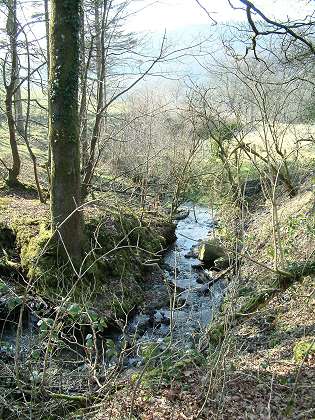
Images of Wales
Llanfynydd and the Mystery of Nant Gwilw
Page 1: Llanfynydd Village Page 2: Parish Church Page 3: Discovering Nant Gwilw
Page 4: Inside Nant Gwilw Updates: Latest findings
 |
|
Gwilw Brook
In Welsh, Nant Gwilw means Gwilw Brook, and sure enough, a small stream (left) flows alongside the property, under the access lane, and down between two fields (below). The stream eventually empties into Afon Cothi.
It is clear that the stream is the origin of the name of the property. |
The topic which prompted my urge to find Nant Gwilw was the existence of an iris bearing the name Nant Gwilw. The story was that a wild iris from Nant Gwilw had been taken to America and named after the place in which it was found.
Unfortunately, mid February is too early in the season to find evidence of irises growing on the banks of Nant Gwilw. Instead, I found a glorious display of snowdrops, their white flower-heads and green foliage contrasting against the carpet of fallen leaves.
Can you help solve the mystery of Nant Gwilw?
Please write to me, John Ball, via my Contact Page if you know anything more about the history of the property called Nant Gwilw, the Unicorn Books publishing house, or the iris named Nant Gwilw.
(Grid Reference for Nant Gwilw is SN534268)
Postscript (added 20 March 2003)
Carla Lankow of Washington State, USA, has kindly provided some information about the Nant Gwilw iris:
I was a friend of the late Roy Davidson who was the one who collected the iris Nant Gwilw. The iris is a very nice form of Iris foetidissima that is a lovely lavender color rather than the rather dirty tan of the common forms of this species. It is sometimes known as the roast beef iris, referring to the smell of the crushed leaves. I never quite got that smell out of it but foetidissima did seem to be a good species name!
Roy told the story about the name of the iris as follows. He named the iris after a stream near where he collected the iris. He told us that
"Nant" meant "river", well that is close to brook, right? Roy told us that the river got its name because in ancient times there was a great battle fought along this stream and so many died on its banks that the river ran red with blood. Thus the river was named Gwilw which meant red or bloody or sanguine or some such thing.
I grow the iris myself and would really like to know if the story Roy told was at all true. It is still a pretty iris! You said that you saw no
irises when you visited Nant Gwilw because of the time of the year, however this iris is evergreen and the foliage would have been there even in February. Probably Roy collected the iris some where upstream or down stream from where you were or else, like so many wild flowers all over the world, the I. foetidissima in that area is now gone. It was named and registered in 1979 and I do not know how long before that Roy Davidson collected it. |
Unfortunately, I can find no record of a battle ever having taken place in the vicinity of Nant Gwilw. Perhaps the battle was mythical rather than real? The brook known as Nant Gwilw is only about 12 inches across and ½ mile long, measured from its source to the point where it flows into the river Cothi.
Nor can I find any reference to the word gwilw being used to mean red or bloody or sanguine. Indeed, the word is in none of the Welsh dictionaries I have checked. They show that the Welsh word for red is coch; the Welsh word for bloody is gwaedlyd; blood is gwaed, and haemorrhage is gwaedlif. The Welsh words for sanguine are gwridog, hyderus, or gobeithiol.
Many thanks to Carla Lankow for providing me with this story of the Nant Gwilw iris.
John Ball - 20 March 2003
Page 1: Llanfynydd Village Page 2: Parish Church Page 3: Discovering Nant Gwilw Page 4: Inside Nant Gwilw
|